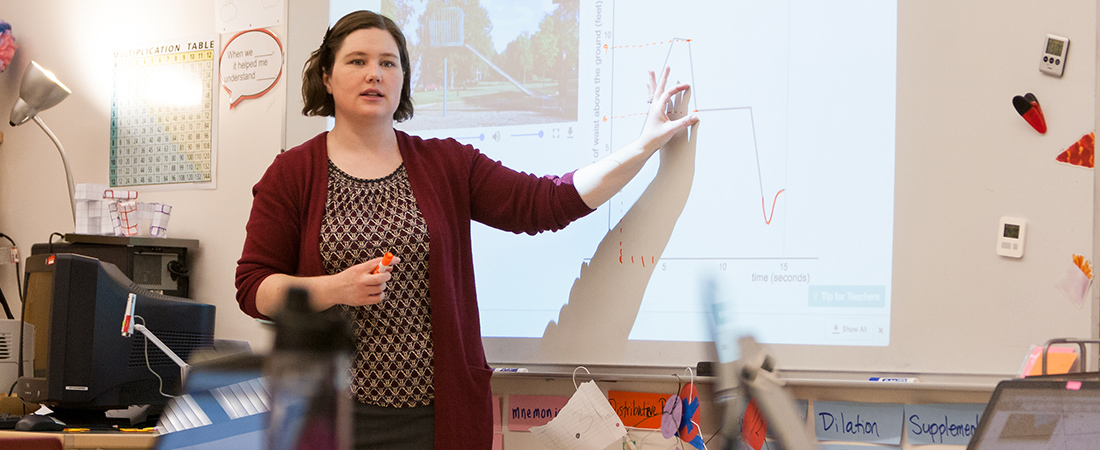What Does Extra Math Add Up to in the Middle Grades?

“My main goal is to help students be better mathematical thinkers,” says Theresa MacVicar.
Learn more about mathematics intervention classes for middle grades in the National Survey on Supporting Struggling Mathematics Learners in the Middle Grades: Executive Summary.
It’s 9 a.m. on a blustery February morning in Waltham, Massachusetts, and some of Theresa MacVicar’s eighth-grade students are already in their second mathematics class of the day. MacVicar teaches MathLab, a mathematics intervention class in which students study concepts they have struggled with in the past, such as fractions and functions, but which are essential for success in algebra. Each of the seven students in this MathLab section takes a standard grade-level mathematics class, too.
MacVicar has latitude in how she presents the content. Students sometimes play math games to build fluency with fraction operations; other times, they have wide-ranging discussions about mathematics in the real world. Today, they are watching brief videos of objects in motion on their Chromebooks and then making graphs that chart the objects’ positions over time. The room is quiet as they work.
MacVicar, who teaches four sections of MathLab, tries to keep things fresh because she knows that many of her students come to MathLab doubting their own abilities in mathematics. She wants to change that because an aversion to mathematics now could have a significant impact down the road.
“My main goal is to help students be better mathematical thinkers,” she says. “I don’t want them to decide in three years that they want to be a doctor, but that they can’t do that because they never learned algebra.”
With two-thirds of U.S. eighth graders scoring “below proficient” in mathematics on the National Assessment of Educational Progress, mathematics intervention courses like MathLab are becoming more popular across the country. A new study from EDC finds that 69 percent of public schools now offer some form of mathematics intervention classes for middle grade students, and in approximately half of these schools, these classes meet daily.
“Prior to this study, little was known about the extent to which schools were implementing intervention classes in grades 6, 7, and 8,” says EDC’s Amy Brodesky, who led the research, which was funded by the National Science Foundation. “From our experience working with schools locally, we knew that it was a trend here in Massachusetts. Now, as a result of the study, this definitely seems like a national trend as well.”
Insights into classroom practice
To better understand how mathematics intervention classes were being used, Brodesky and other EDC researchers developed and distributed an online survey to 2,024 public schools with students in grades 6 through 8. They also conducted observations of mathematics intervention classes and interviewed teachers and administrators. The resulting report is the first national-level look at who attends math intervention classes, who teaches them, and what challenges schools face in implementing them.
Doubling up on mathematics instruction time has big implications for other parts of the school day. Brodesky found that 52 percent of schools schedule mathematics intervention classes in place of a non-core subject, such as an elective. But that’s not the only way to do it: 37 percent of schools created a special block where all students took either an intervention class or an enrichment course.
Researchers also found that all mathematics intervention classes are not created equal. Mathematics intervention classes in southern and western schools tended to be larger than similar classes in the Northeast and the Midwest. And across all regions, mathematics intervention classes tended to be larger in high-poverty schools than in low-poverty schools.
“In some places these intervention classes are as large as regular classes, so that raises a red flag,” says Brodesky. “Teachers have to be problem solvers in these intervention classes. They’re trying to address gaps and misconceptions, and provide instruction that’s targeted to each student. If teachers have a smaller group of students, then they are better able to achieve their goals.”
The study has provided valuable insights into the use of mathematics intervention courses. But it has also left Brodesky with one more question: Is this extra mathematics time having a positive impact on student outcomes?
“Very little is known about what teachers and students are actually doing in these classes,” she says. “Administrators and their staffs are making some really difficult decisions to get these classes into the school schedule. It would be helpful to know more about the different models being used and how they compare in their effectiveness for student learning.”
Making a difference
For MacVicar, the small-class, differentiated instruction approach is working very well. She coordinates with the other seventh- and eighth-grade teachers at her school and tailors her instruction to address gaps in foundational understanding and to reinforce concepts and skills that students will see in their grade-level classes. And because her classes are small—maxing out at 12 students—she can have lots of one-on-one time with her students.
This approach has yielded academic success, too. Last year, MathLab students showed academic gains in their grade-level mathematics classes by the end of the year. And on last spring’s Massachusetts Comprehensive Assessment System (MCAS), the state-wide assessment, MacVicar’s eighth-grade students scored in the 89th percentile as measured by a student growth percentile (SGP). (The SGP indicates how much a cohort of learners improved when compared to students with similar MCAS scores the previous year.)
And what about students’ ability to see themselves as successful mathematics students—the area that she cares most about? MacVicar has seen significant progress there, as well.
“Their eighth-grade math teachers tell me, ‘Your MathLab kids are the ones who participate the most—they always get it right away!’” she says. “They’re not the neediest kids in math class anymore.”